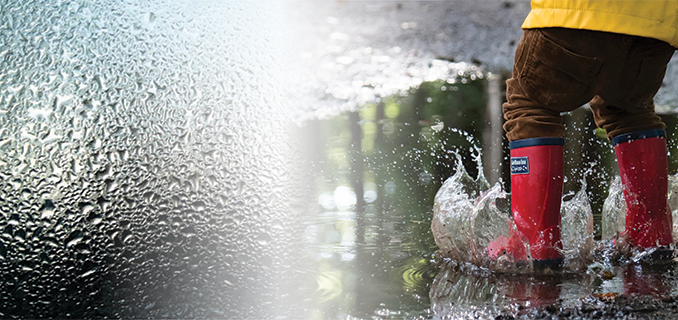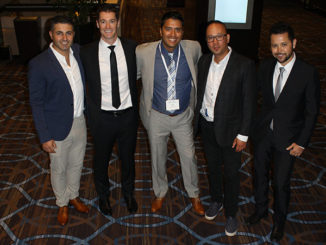
It’s that time of year (depending on where you live) where the snow has melted, geese are starting to fly back north, streets are being cleaned, and Mother Nature is starting to show her colours again. Old Man Winter seems to finally be moving along and we start to get a taste of the summer season.
In many regions with air temperatures on the rise, we welcome our “wet season”—the time of year when a region’s average annual rainfall occurs at its highest. If you haven’t guessed by the title of this blog, this time of year can point to a long-existing phenomenon that has very much to do with changes in the season, and how it could affect many of our end users and applicators.
The majority of outdoor mechanical insulation systems require two main components, insulation and cladding. In particular, aluminum cladding is one of the most common used for the protection of insulation. On pipes, typically cut and rolled jacketing is applied, while on tanks, vessels, and other equipment, flat or corrugated sheets are used.
Aluminum is often used as it is not only cost effective, but durable, visually appealing, and naturally resistant to corrosion. Unlike other metals, it takes care of itself. When exposed to dry or moist air it actually combines with oxygen to form a tough, transparent, protective oxide coating. In the presence of moisture, aluminum will not rust like steel will. That said, users must understand that under certain conditions, aluminum will stain, therefore creating a visually unappealing and undesirable appearance. The stain does not necessarily compensate the overall strength and integrity of the metal jacketing, but may hinder installation, application, and it sure doesn’t look aesthetically attractive.
Water Stain Causes
A main reason for water stains is simply the presence of prolonged trapped moisture. The reaction causes a water stain that is difficult to remove. If there is no air flow to remove the moisture, prolonged contact between the water and the metal causes a reaction between the two, which results in an undesirable water stain.
Virtually all staining problems occur during shipping, handling, or storage. In order to help users address these issues, we will be discussing sources of moisture and prevention best practices.
Main Sources of Moisture
Two main sources of moisture are external and condensation build up. External sources include rain, snow, and water leaks. A simple leak in a tarp or roof covering of stored metal can cause staining.
Condensation is another source of moisture that can be easily overlooked or an afterthought. Many do not anticipate nor plan for condensation as it can be a bit more complex and difficult to understand or control, especially when transporting material over long distances with different climates.
Condensation occurs when warm air collides with cold surfaces or when there’s too much humidity in the atmosphere. When this moisture-packed warm air comes into contact with a chilly surface, it cools down quickly and releases the water, which turns into liquid droplets on the cold surface.
Dew point is the temperature at which water vapor from the air begins to condense and is affected by the relative humidity and temperature of the air. Water vapor condenses on the surface if the temperature of the metal drops below the dew point of the surrounding air. A familiar example of condensation is when your eyeglasses fog up when entering a warm room after being in the cold outdoors. Another common example is moisture on the outside of a cold beverage container during a hot sunny day. When the temperature of aluminum drops below the dew point of air, water comes out of the air and deposits on the surface of the aluminum. The temperature of the aluminum can drop below the dew point of the air under various circumstances such as during storage, transport, or moving cold metal into warm storage.
Prevention
Now that we have a better understanding of where and how staining happens, what can one do to help prevent and protect their metal? Here are some key points to consider:
1. Eliminate Moisture:
- Prevent any moisture to come into contact with the metal
- Remove any known moisture as quickly as possible
2. Storage:
- Intact packages should be stored in a dry area with good ventilation to ensure stabilization of the package.
- When storing metal, it is not recommended to leave warehouse doors open, especially during the spring and fall months when there may be extreme differences in temperature between day and night. During the night, cold air enters and temperature and humidity of the air increase rapidly, the dew point rises quickly. But, the temperature of the aluminum increases at a much slower rate; this sets up the condition where water begins to condense on the surface of the aluminum. As you can imagine, this process is not limited to fall and spring months but may occur whenever there are large enough fluctuations in temperature and humidity.
- Rotate stock as quickly as possible.
- Neither packaged nor bare aluminum should be stored outdoors.
3. Transport:
- When transporting metal, consider things like whether the metal is removed from a cool or cold storage area into a warm trailer or railroad car on a humid day. This can thus result in condensation on the aluminum and can occur during any season of the year; however, for some areas it may be more pronounced in summer.
- Minimize day/night temperature cycling during typical storage and/or transit, and the preferred method is to use insulated trucks or rail cars. It is essential that long layovers at truck and rail depots are minimized.
- Ensure all open transit shipments are covered with waterproof tarping.
- Use portable, temperature/humidity recorders for critical products.
- Minimize in-transit times and temperature cycling as much as possible.
- Allow metal to warm up slowly when receiving shipments that have allowed the material to drop below your destination atmospheric temperature. Do not move cold metal into a warm storage area right away.
Conclusion
While after reading all of this it may seem a bit overwhelming, but be reminded that aluminum is still one of the better choices for cladding and protection. Not only is it cost effective, but it is still very durable and naturally resistant to corrosion. In the presence of moisture, aluminum will not rust like steel will. If you look around close enough, aluminum is used in many areas or everyday life such as cars, refrigerators, electric power lines, computers, kitchenware, and many more.
Again however, aluminum like many other things can be susceptible to water staining. Awareness is important, and taking necessary measures to protect your investment may be something you want to consider.
Six key points to summarize:
- Be mindful of climate changes. Do not move cold metal into a warm storage area right away (remember the cold beverage container on a hot day). Allow the metal to warm up slowly.
- Store aluminum in a dry place, preferably inside.
- If stored outside, cover with a waterproof tarp.
- Protect while transporting. Use insulated or heated trailers whenever possible.
- If moisture is present, wipe dry right away.
- Conduct periodic inspections.
While staining does not necessarily affect the integrity of the material itself, it does cause for some undesired aesthetics and possible issues while processing. Some staining can be removed carefully through various techniques, but you probably don’t want to have an issue in the first place.
How are you protecting and preventing your aluminum from staining?
For more information please feel free to email Ideal Products at info@idealproducts.ca ▪



